Higher National Certificate in Construction: Mathematics Assignment
VerifiedAdded on 2022/12/28
|19
|2862
|24
Homework Assignment
AI Summary
This assignment solution covers various mathematical problems relevant to the construction and built environment field. It includes solutions for quadratic equations, calculations involving areas, and dimensional analysis. The assignment also delves into geometric progressions, logarithmic equations, and hyperbolic functions. Furthermore, it addresses statistical concepts like median, quartiles, mean, and standard deviation applied to construction scenarios. The solution also includes calculations for bending moments, exponential functions, and vector equations, providing a comprehensive overview of mathematical techniques used in construction. The student has attempted and solved all the given tasks of the assignment.
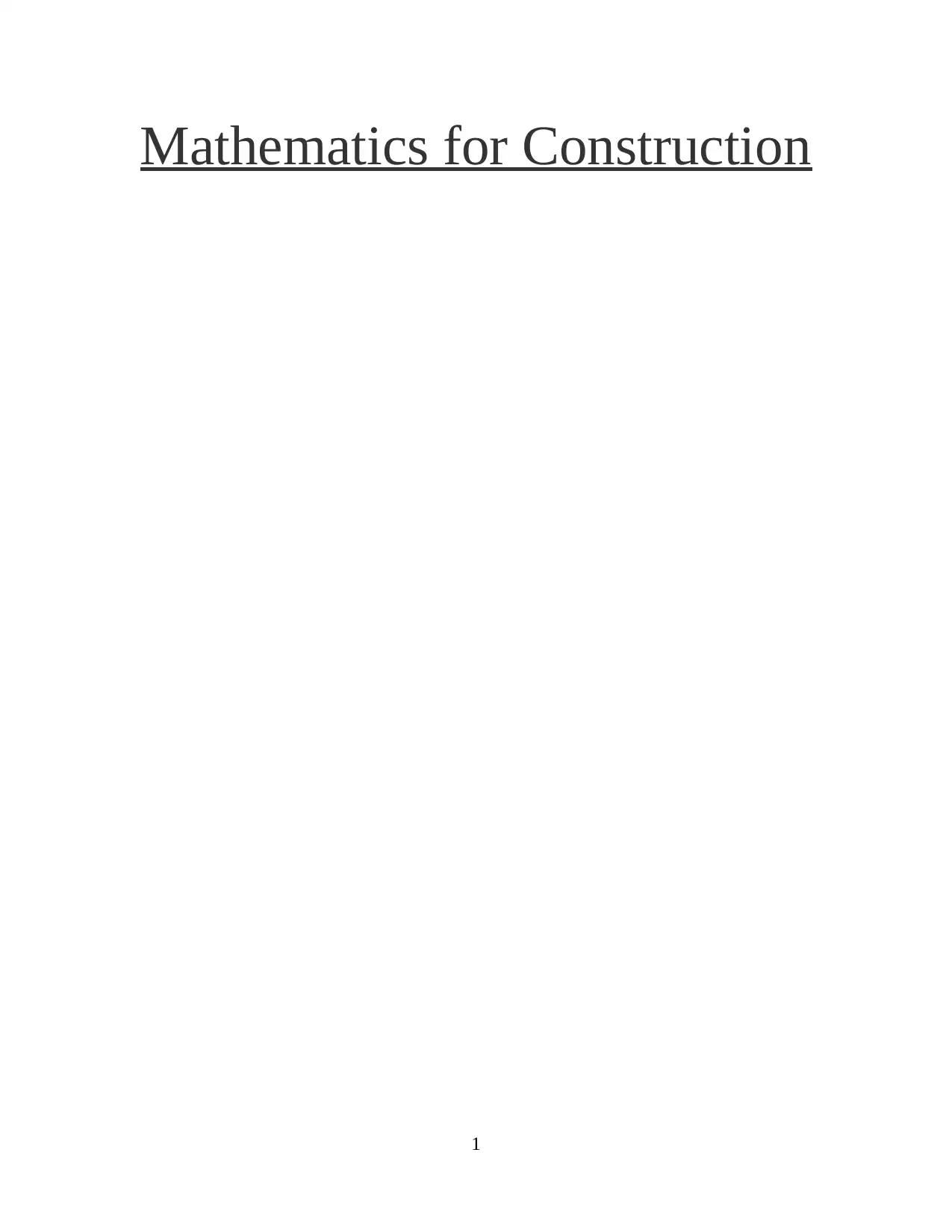
Mathematics for Construction
1
1
Paraphrase This Document
Need a fresh take? Get an instant paraphrase of this document with our AI Paraphraser
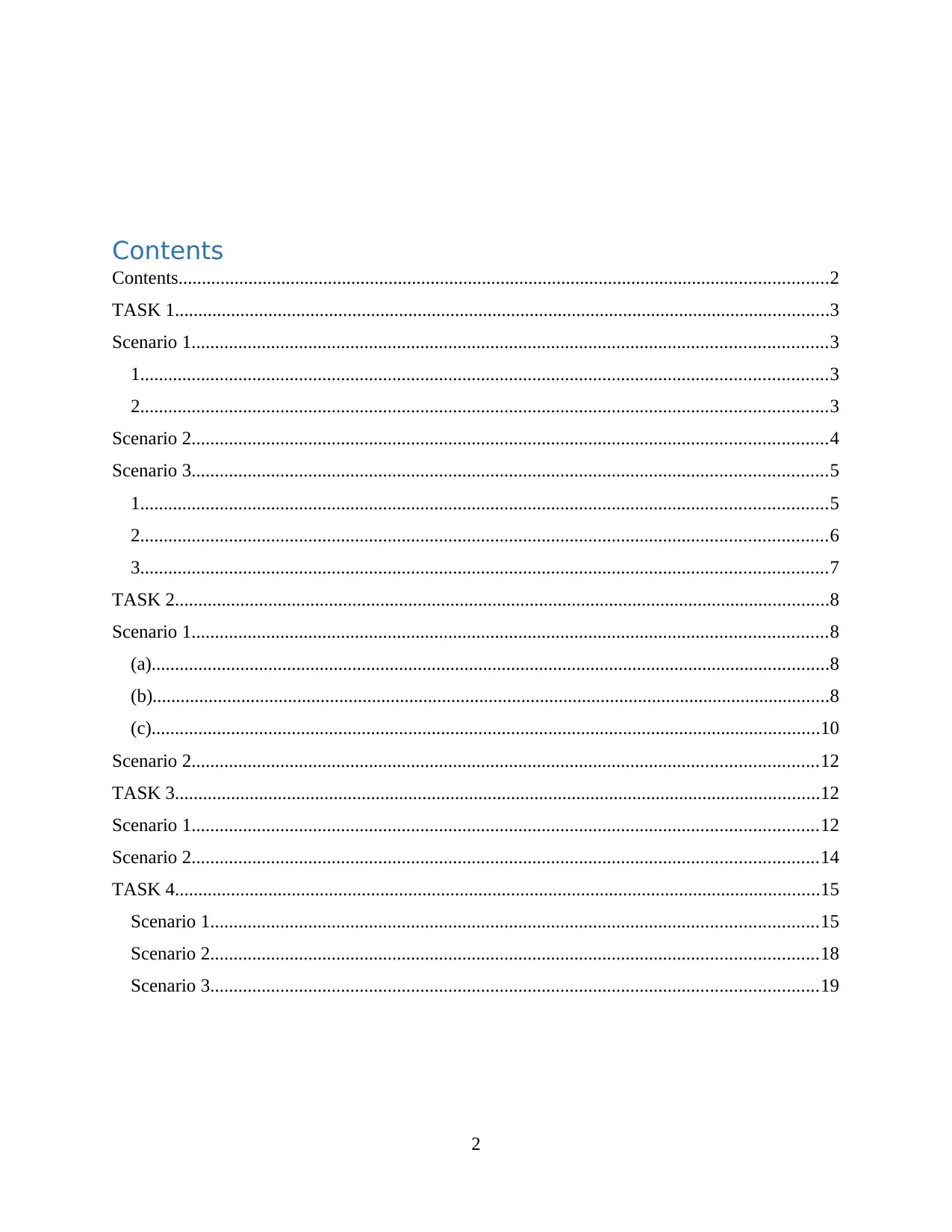
Contents
Contents...........................................................................................................................................2
TASK 1............................................................................................................................................3
Scenario 1........................................................................................................................................3
1...................................................................................................................................................3
2...................................................................................................................................................3
Scenario 2........................................................................................................................................4
Scenario 3........................................................................................................................................5
1...................................................................................................................................................5
2...................................................................................................................................................6
3...................................................................................................................................................7
TASK 2............................................................................................................................................8
Scenario 1........................................................................................................................................8
(a).................................................................................................................................................8
(b).................................................................................................................................................8
(c)...............................................................................................................................................10
Scenario 2......................................................................................................................................12
TASK 3..........................................................................................................................................12
Scenario 1......................................................................................................................................12
Scenario 2......................................................................................................................................14
TASK 4..........................................................................................................................................15
Scenario 1..................................................................................................................................15
Scenario 2..................................................................................................................................18
Scenario 3..................................................................................................................................19
2
Contents...........................................................................................................................................2
TASK 1............................................................................................................................................3
Scenario 1........................................................................................................................................3
1...................................................................................................................................................3
2...................................................................................................................................................3
Scenario 2........................................................................................................................................4
Scenario 3........................................................................................................................................5
1...................................................................................................................................................5
2...................................................................................................................................................6
3...................................................................................................................................................7
TASK 2............................................................................................................................................8
Scenario 1........................................................................................................................................8
(a).................................................................................................................................................8
(b).................................................................................................................................................8
(c)...............................................................................................................................................10
Scenario 2......................................................................................................................................12
TASK 3..........................................................................................................................................12
Scenario 1......................................................................................................................................12
Scenario 2......................................................................................................................................14
TASK 4..........................................................................................................................................15
Scenario 1..................................................................................................................................15
Scenario 2..................................................................................................................................18
Scenario 3..................................................................................................................................19
2
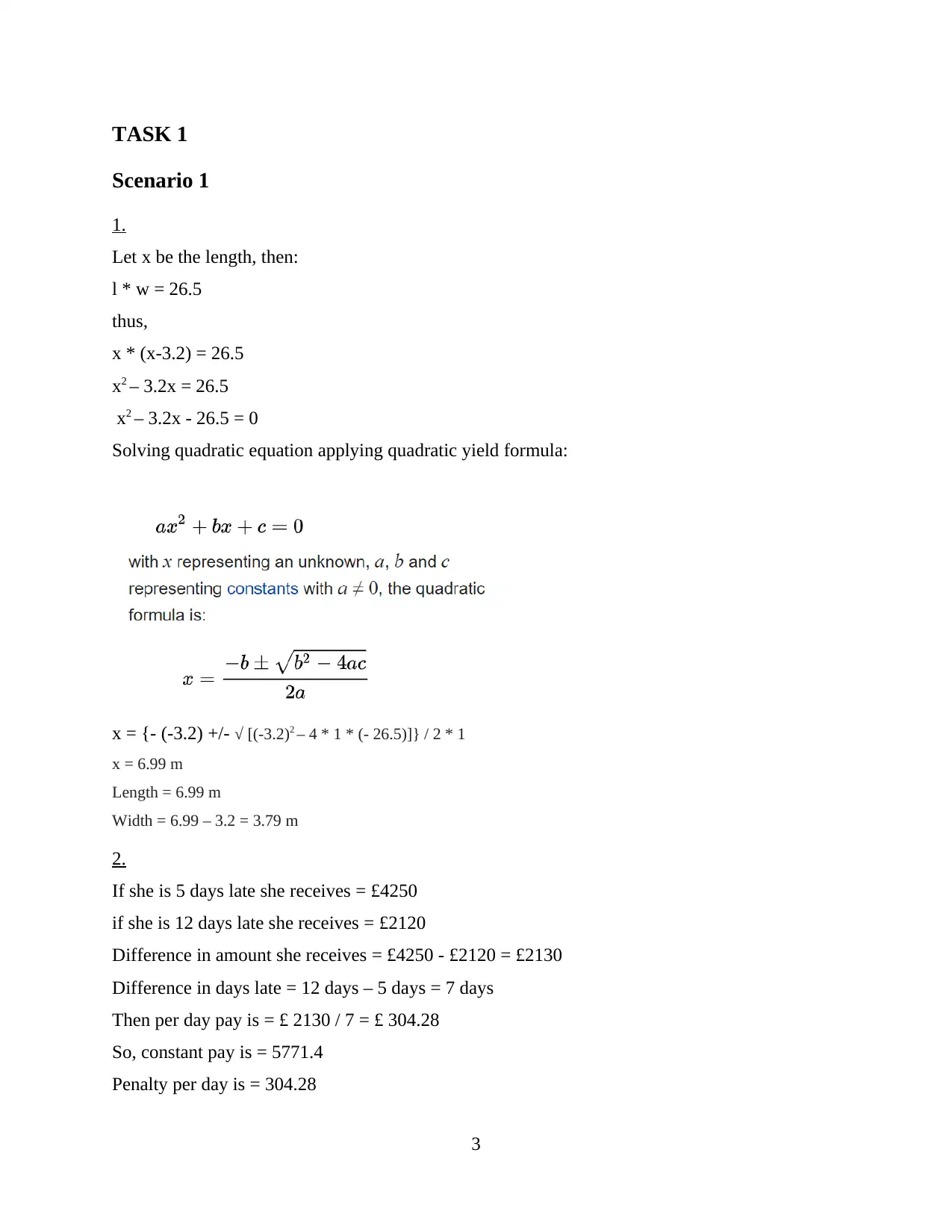
TASK 1
Scenario 1
1.
Let x be the length, then:
l * w = 26.5
thus,
x * (x-3.2) = 26.5
x2 – 3.2x = 26.5
x2 – 3.2x - 26.5 = 0
Solving quadratic equation applying quadratic yield formula:
x = {- (-3.2) +/- √ [(-3.2)2 – 4 * 1 * (- 26.5)]} / 2 * 1
x = 6.99 m
Length = 6.99 m
Width = 6.99 – 3.2 = 3.79 m
2.
If she is 5 days late she receives = £4250
if she is 12 days late she receives = £2120
Difference in amount she receives = £4250 - £2120 = £2130
Difference in days late = 12 days – 5 days = 7 days
Then per day pay is = £ 2130 / 7 = £ 304.28
So, constant pay is = 5771.4
Penalty per day is = 304.28
3
Scenario 1
1.
Let x be the length, then:
l * w = 26.5
thus,
x * (x-3.2) = 26.5
x2 – 3.2x = 26.5
x2 – 3.2x - 26.5 = 0
Solving quadratic equation applying quadratic yield formula:
x = {- (-3.2) +/- √ [(-3.2)2 – 4 * 1 * (- 26.5)]} / 2 * 1
x = 6.99 m
Length = 6.99 m
Width = 6.99 – 3.2 = 3.79 m
2.
If she is 5 days late she receives = £4250
if she is 12 days late she receives = £2120
Difference in amount she receives = £4250 - £2120 = £2130
Difference in days late = 12 days – 5 days = 7 days
Then per day pay is = £ 2130 / 7 = £ 304.28
So, constant pay is = 5771.4
Penalty per day is = 304.28
3
⊘ This is a preview!⊘
Do you want full access?
Subscribe today to unlock all pages.

Trusted by 1+ million students worldwide

Scenario 2
A
i. Fd = 0.5 * * u2 * Cd * A
Solution
Fd = Force thus its dimension is: [M1L1T-2]
Similarly, on Right hand side
= density = kg / meter cube = [M1L-3T0]
A = meter square = [M0L2T0]
Cd = No dimension
u2 = velocity = u2 = [meter/ second]2 = [M0L2T-2]
0.5 * * u2 * Cd * A = [M1L-3T0] * [M0L2T-2] * [M0L2T0]
= [M1L1T-2]
Thus LHS = RHS and equation can be said to be dimensionally correct.
ii) Power (P) = [M1L2T-3]
Weight (W) = [M1L-2T-2]
Height (h) = [M0L1T0]
Fluid flow rate (q) = [M0L3T-1]
Solution
Power is proportional to W; h and q thus :
Power = flow rate * work done
P = q * Work
Work = mass * height * gravity
Work = (Weight /G) * h * g
G and g can be considered as constant
Thus dimension of work = dimension of weight * dimension of height
dimension of work = [M1L-2T-2] * [M0L1T0]
Power = flow rate * work done
= [M0L3T-1] * [M1L-2T-2] * [M0L1T0]
4
A
i. Fd = 0.5 * * u2 * Cd * A
Solution
Fd = Force thus its dimension is: [M1L1T-2]
Similarly, on Right hand side
= density = kg / meter cube = [M1L-3T0]
A = meter square = [M0L2T0]
Cd = No dimension
u2 = velocity = u2 = [meter/ second]2 = [M0L2T-2]
0.5 * * u2 * Cd * A = [M1L-3T0] * [M0L2T-2] * [M0L2T0]
= [M1L1T-2]
Thus LHS = RHS and equation can be said to be dimensionally correct.
ii) Power (P) = [M1L2T-3]
Weight (W) = [M1L-2T-2]
Height (h) = [M0L1T0]
Fluid flow rate (q) = [M0L3T-1]
Solution
Power is proportional to W; h and q thus :
Power = flow rate * work done
P = q * Work
Work = mass * height * gravity
Work = (Weight /G) * h * g
G and g can be considered as constant
Thus dimension of work = dimension of weight * dimension of height
dimension of work = [M1L-2T-2] * [M0L1T0]
Power = flow rate * work done
= [M0L3T-1] * [M1L-2T-2] * [M0L1T0]
4
Paraphrase This Document
Need a fresh take? Get an instant paraphrase of this document with our AI Paraphraser
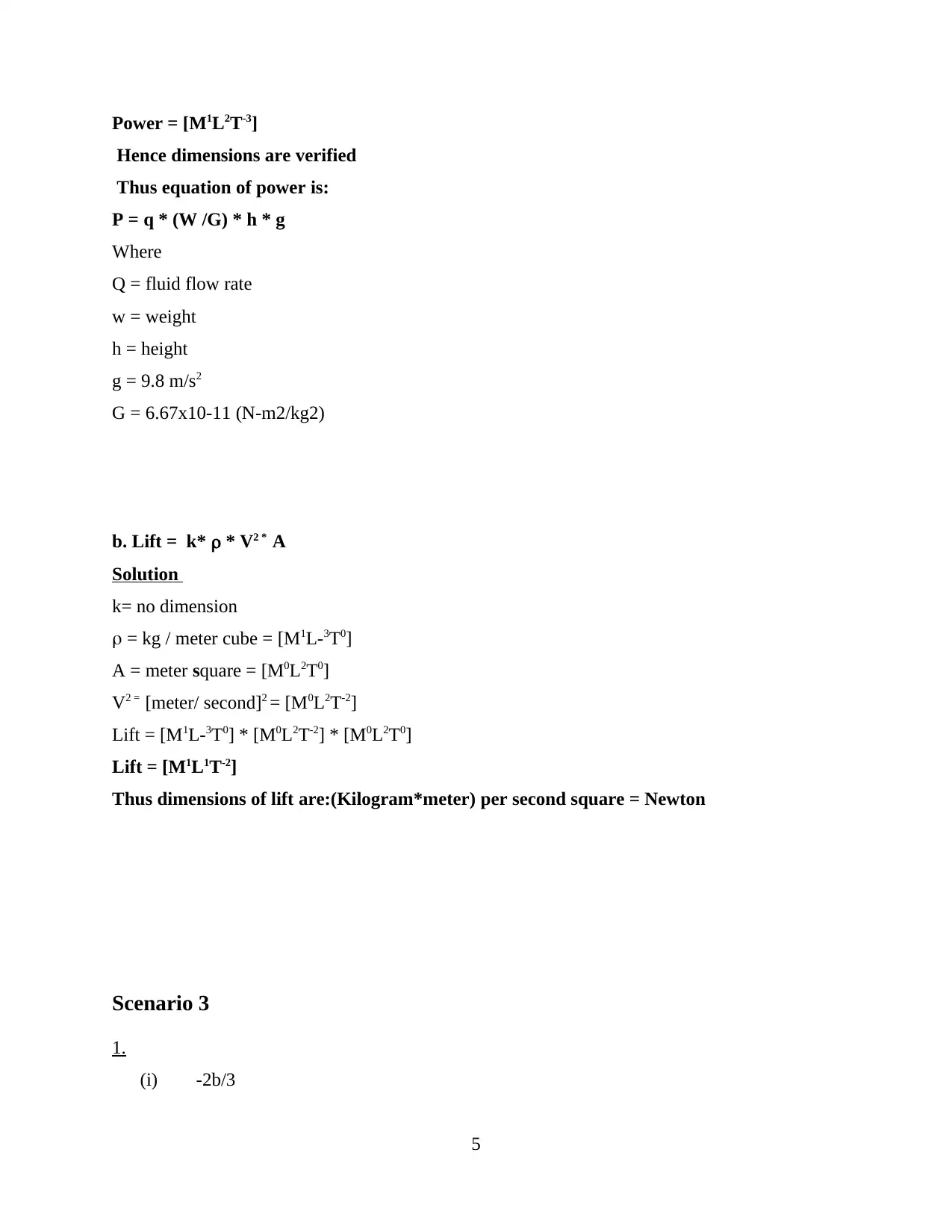
Power = [M1L2T-3]
Hence dimensions are verified
Thus equation of power is:
P = q * (W /G) * h * g
Where
Q = fluid flow rate
w = weight
h = height
g = 9.8 m/s2
G = 6.67x10-11 (N-m2/kg2)
b. Lift = k* * V2 * A
Solution
k= no dimension
= kg / meter cube = [M1L-3T0]
A = meter square = [M0L2T0]
V2 = [meter/ second]2 = [M0L2T-2]
Lift = [M1L-3T0] * [M0L2T-2] * [M0L2T0]
Lift = [M1L1T-2]
Thus dimensions of lift are:(Kilogram*meter) per second square = Newton
Scenario 3
1.
(i) -2b/3
5
Hence dimensions are verified
Thus equation of power is:
P = q * (W /G) * h * g
Where
Q = fluid flow rate
w = weight
h = height
g = 9.8 m/s2
G = 6.67x10-11 (N-m2/kg2)
b. Lift = k* * V2 * A
Solution
k= no dimension
= kg / meter cube = [M1L-3T0]
A = meter square = [M0L2T0]
V2 = [meter/ second]2 = [M0L2T-2]
Lift = [M1L-3T0] * [M0L2T-2] * [M0L2T0]
Lift = [M1L1T-2]
Thus dimensions of lift are:(Kilogram*meter) per second square = Newton
Scenario 3
1.
(i) -2b/3
5
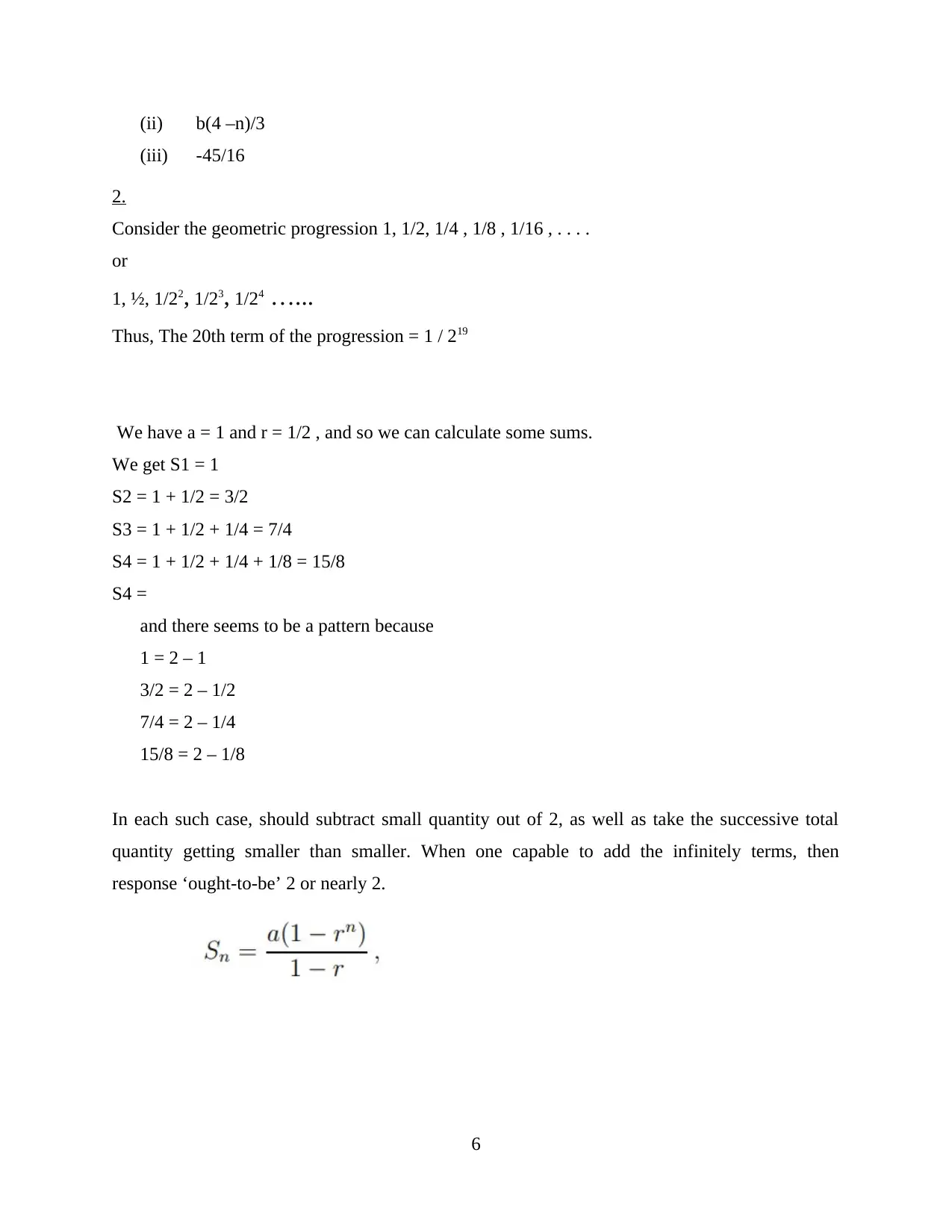
(ii) b(4 –n)/3
(iii) -45/16
2.
Consider the geometric progression 1, 1/2, 1/4 , 1/8 , 1/16 , . . . .
or
1, ½, 1/22, 1/23, 1/24 …...
Thus, The 20th term of the progression = 1 / 219
We have a = 1 and r = 1/2 , and so we can calculate some sums.
We get S1 = 1
S2 = 1 + 1/2 = 3/2
S3 = 1 + 1/2 + 1/4 = 7/4
S4 = 1 + 1/2 + 1/4 + 1/8 = 15/8
S4 =
and there seems to be a pattern because
1 = 2 – 1
3/2 = 2 – 1/2
7/4 = 2 – 1/4
15/8 = 2 – 1/8
In each such case, should subtract small quantity out of 2, as well as take the successive total
quantity getting smaller than smaller. When one capable to add the infinitely terms, then
response ‘ought-to-be’ 2 or nearly 2.
6
(iii) -45/16
2.
Consider the geometric progression 1, 1/2, 1/4 , 1/8 , 1/16 , . . . .
or
1, ½, 1/22, 1/23, 1/24 …...
Thus, The 20th term of the progression = 1 / 219
We have a = 1 and r = 1/2 , and so we can calculate some sums.
We get S1 = 1
S2 = 1 + 1/2 = 3/2
S3 = 1 + 1/2 + 1/4 = 7/4
S4 = 1 + 1/2 + 1/4 + 1/8 = 15/8
S4 =
and there seems to be a pattern because
1 = 2 – 1
3/2 = 2 – 1/2
7/4 = 2 – 1/4
15/8 = 2 – 1/8
In each such case, should subtract small quantity out of 2, as well as take the successive total
quantity getting smaller than smaller. When one capable to add the infinitely terms, then
response ‘ought-to-be’ 2 or nearly 2.
6
⊘ This is a preview!⊘
Do you want full access?
Subscribe today to unlock all pages.

Trusted by 1+ million students worldwide
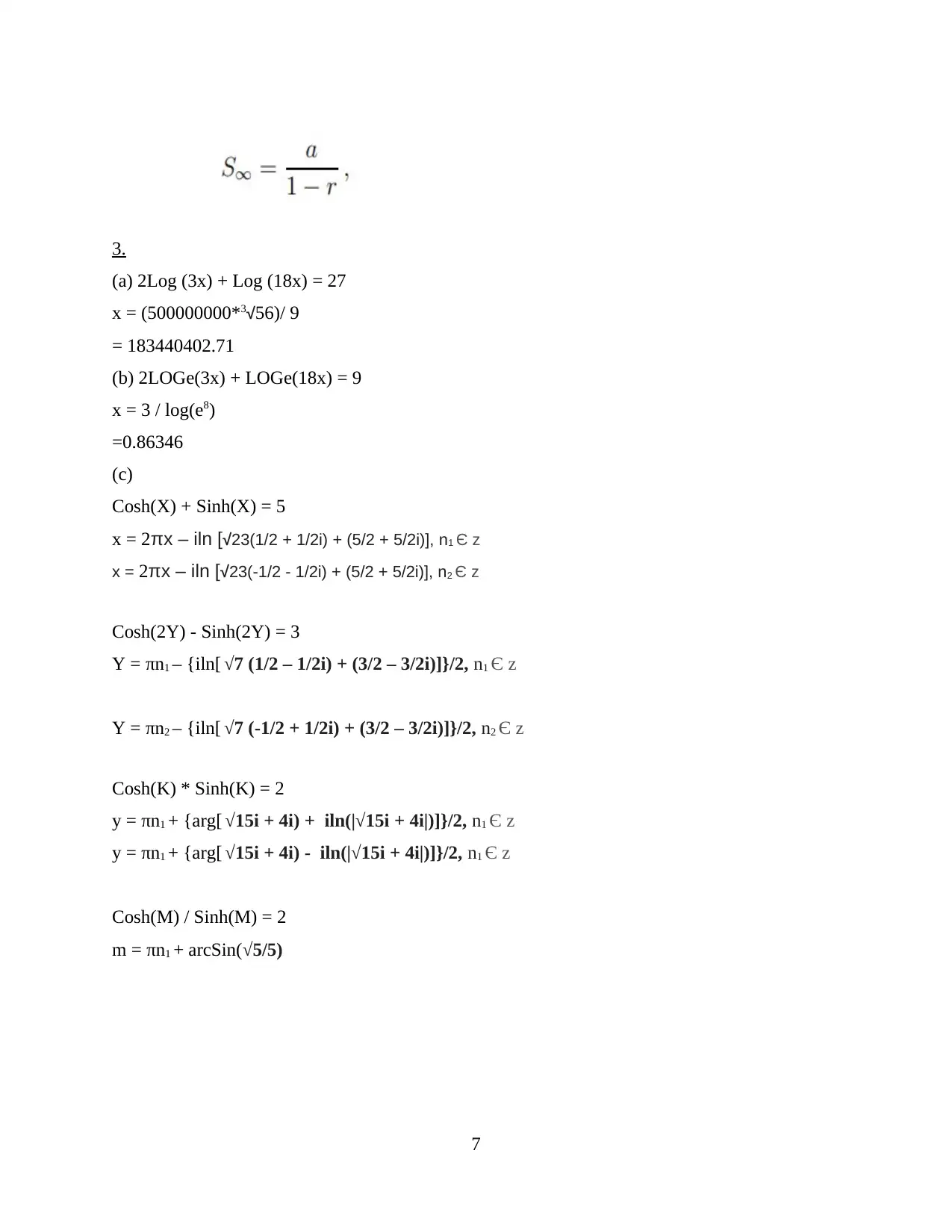
3.
(a) 2Log (3x) + Log (18x) = 27
x = (500000000*3√56)/ 9
= 183440402.71
(b) 2LOGe(3x) + LOGe(18x) = 9
x = 3 / log(e8)
=0.86346
(c)
Cosh(X) + Sinh(X) = 5
x = 2πx – iln [√23(1/2 + 1/2i) + (5/2 + 5/2i)], n1 Є z
x = 2πx – iln [√23(-1/2 - 1/2i) + (5/2 + 5/2i)], n2 Є z
Cosh(2Y) - Sinh(2Y) = 3
Y = πn1 – {iln[ √7 (1/2 – 1/2i) + (3/2 – 3/2i)]}/2, n1 Є z
Y = πn2 – {iln[ √7 (-1/2 + 1/2i) + (3/2 – 3/2i)]}/2, n2 Є z
Cosh(K) * Sinh(K) = 2
y = πn1 + {arg[ √15i + 4i) + iln(|√15i + 4i|)]}/2, n1 Є z
y = πn1 + {arg[ √15i + 4i) - iln(|√15i + 4i|)]}/2, n1 Є z
Cosh(M) / Sinh(M) = 2
m = πn1 + arcSin(√5/5)
7
(a) 2Log (3x) + Log (18x) = 27
x = (500000000*3√56)/ 9
= 183440402.71
(b) 2LOGe(3x) + LOGe(18x) = 9
x = 3 / log(e8)
=0.86346
(c)
Cosh(X) + Sinh(X) = 5
x = 2πx – iln [√23(1/2 + 1/2i) + (5/2 + 5/2i)], n1 Є z
x = 2πx – iln [√23(-1/2 - 1/2i) + (5/2 + 5/2i)], n2 Є z
Cosh(2Y) - Sinh(2Y) = 3
Y = πn1 – {iln[ √7 (1/2 – 1/2i) + (3/2 – 3/2i)]}/2, n1 Є z
Y = πn2 – {iln[ √7 (-1/2 + 1/2i) + (3/2 – 3/2i)]}/2, n2 Є z
Cosh(K) * Sinh(K) = 2
y = πn1 + {arg[ √15i + 4i) + iln(|√15i + 4i|)]}/2, n1 Є z
y = πn1 + {arg[ √15i + 4i) - iln(|√15i + 4i|)]}/2, n1 Є z
Cosh(M) / Sinh(M) = 2
m = πn1 + arcSin(√5/5)
7
Paraphrase This Document
Need a fresh take? Get an instant paraphrase of this document with our AI Paraphraser
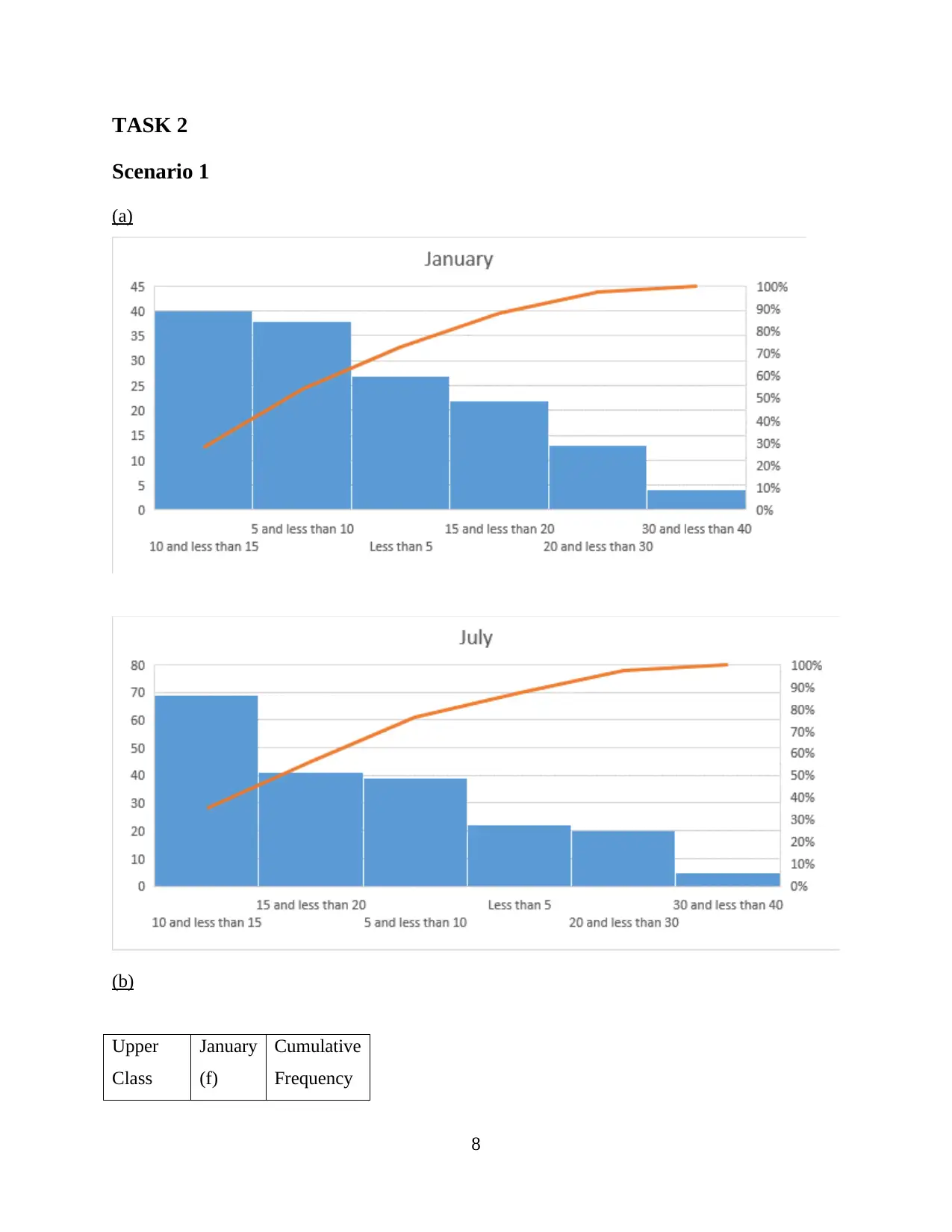
TASK 2
Scenario 1
(a)
(b)
Upper
Class
January
(f)
Cumulative
Frequency
8
Scenario 1
(a)
(b)
Upper
Class
January
(f)
Cumulative
Frequency
8
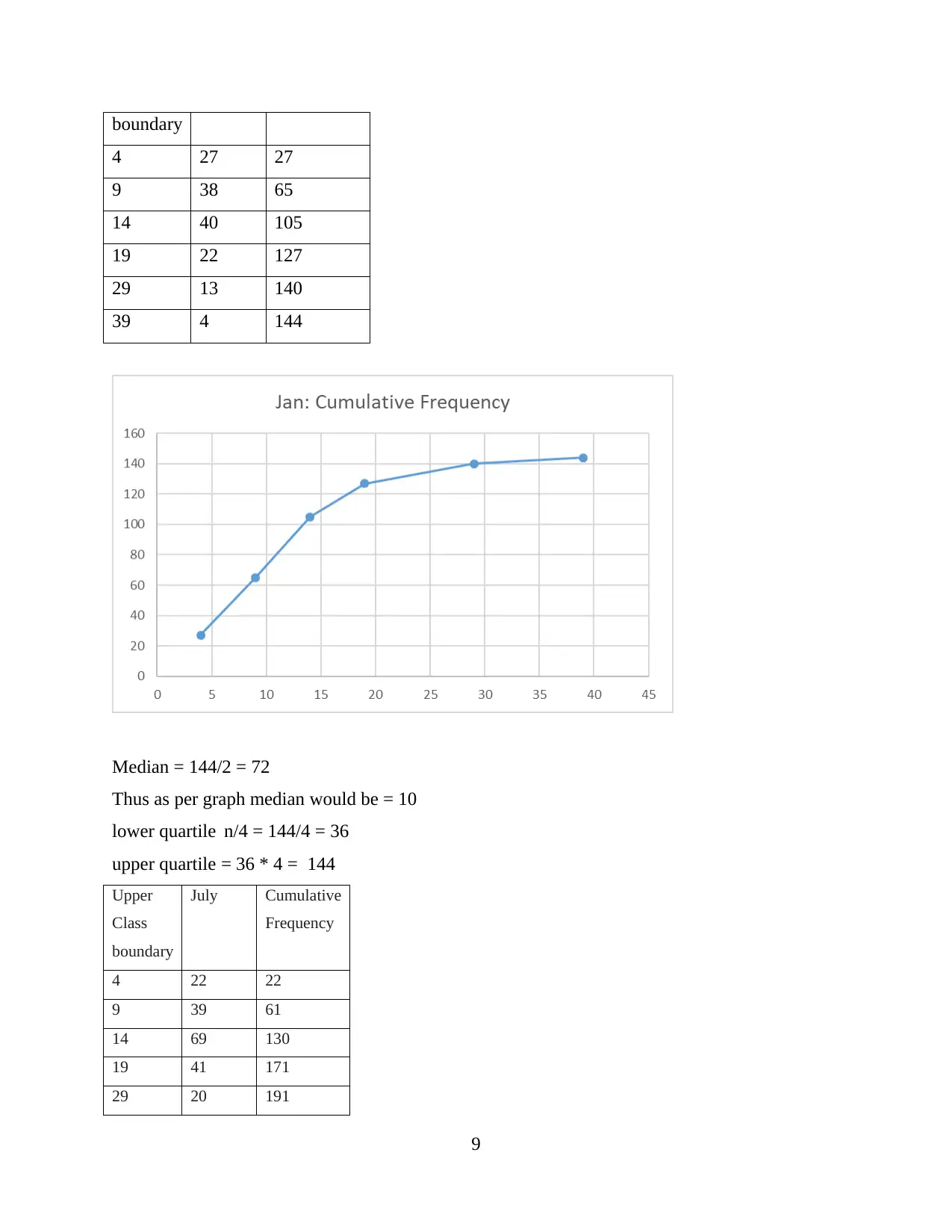
boundary
4 27 27
9 38 65
14 40 105
19 22 127
29 13 140
39 4 144
Median = 144/2 = 72
Thus as per graph median would be = 10
lower quartile n/4 = 144/4 = 36
upper quartile = 36 * 4 = 144
Upper
Class
boundary
July Cumulative
Frequency
4 22 22
9 39 61
14 69 130
19 41 171
29 20 191
9
4 27 27
9 38 65
14 40 105
19 22 127
29 13 140
39 4 144
Median = 144/2 = 72
Thus as per graph median would be = 10
lower quartile n/4 = 144/4 = 36
upper quartile = 36 * 4 = 144
Upper
Class
boundary
July Cumulative
Frequency
4 22 22
9 39 61
14 69 130
19 41 171
29 20 191
9
⊘ This is a preview!⊘
Do you want full access?
Subscribe today to unlock all pages.

Trusted by 1+ million students worldwide
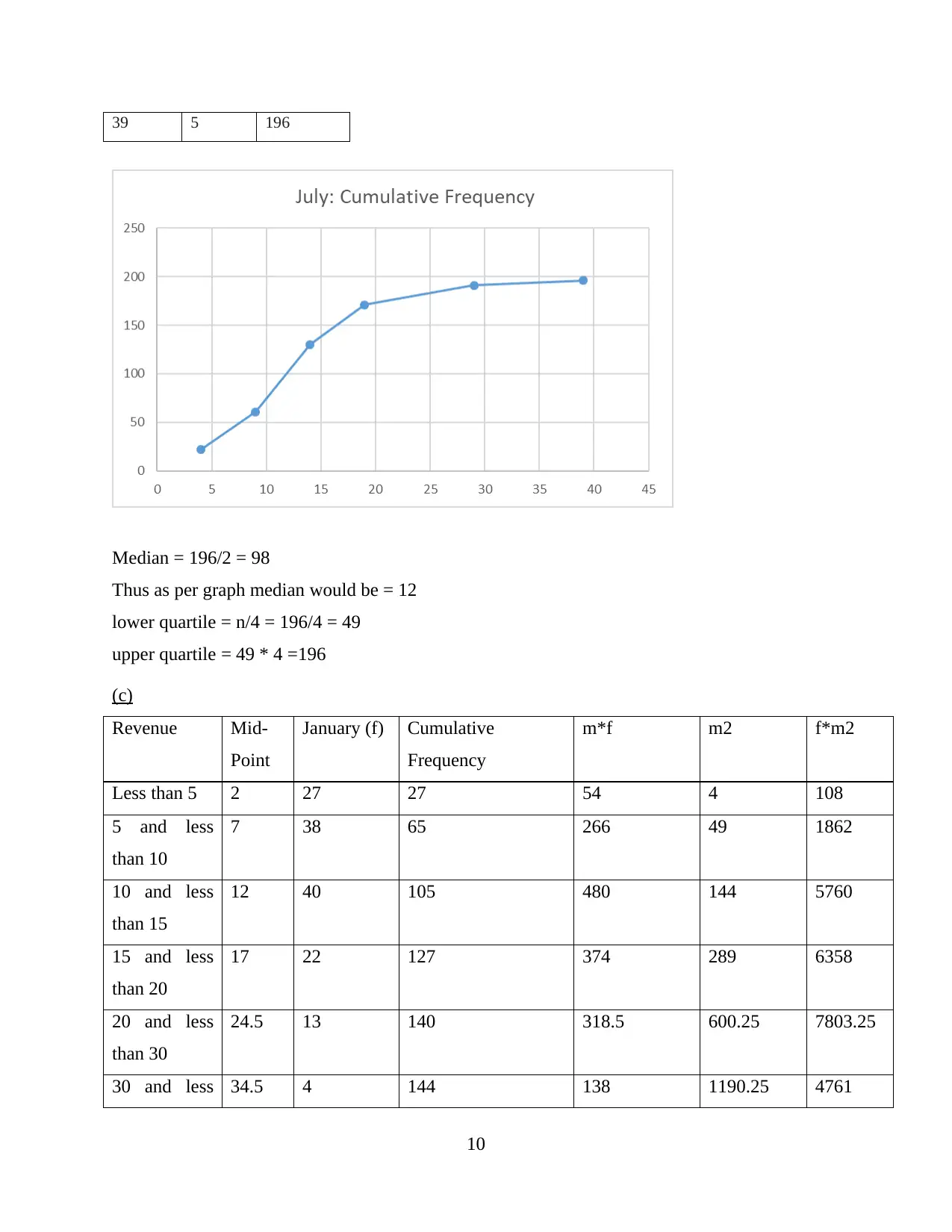
39 5 196
Median = 196/2 = 98
Thus as per graph median would be = 12
lower quartile = n/4 = 196/4 = 49
upper quartile = 49 * 4 =196
(c)
Revenue Mid-
Point
January (f) Cumulative
Frequency
m*f m2 f*m2
Less than 5 2 27 27 54 4 108
5 and less
than 10
7 38 65 266 49 1862
10 and less
than 15
12 40 105 480 144 5760
15 and less
than 20
17 22 127 374 289 6358
20 and less
than 30
24.5 13 140 318.5 600.25 7803.25
30 and less 34.5 4 144 138 1190.25 4761
10
Median = 196/2 = 98
Thus as per graph median would be = 12
lower quartile = n/4 = 196/4 = 49
upper quartile = 49 * 4 =196
(c)
Revenue Mid-
Point
January (f) Cumulative
Frequency
m*f m2 f*m2
Less than 5 2 27 27 54 4 108
5 and less
than 10
7 38 65 266 49 1862
10 and less
than 15
12 40 105 480 144 5760
15 and less
than 20
17 22 127 374 289 6358
20 and less
than 30
24.5 13 140 318.5 600.25 7803.25
30 and less 34.5 4 144 138 1190.25 4761
10
Paraphrase This Document
Need a fresh take? Get an instant paraphrase of this document with our AI Paraphraser
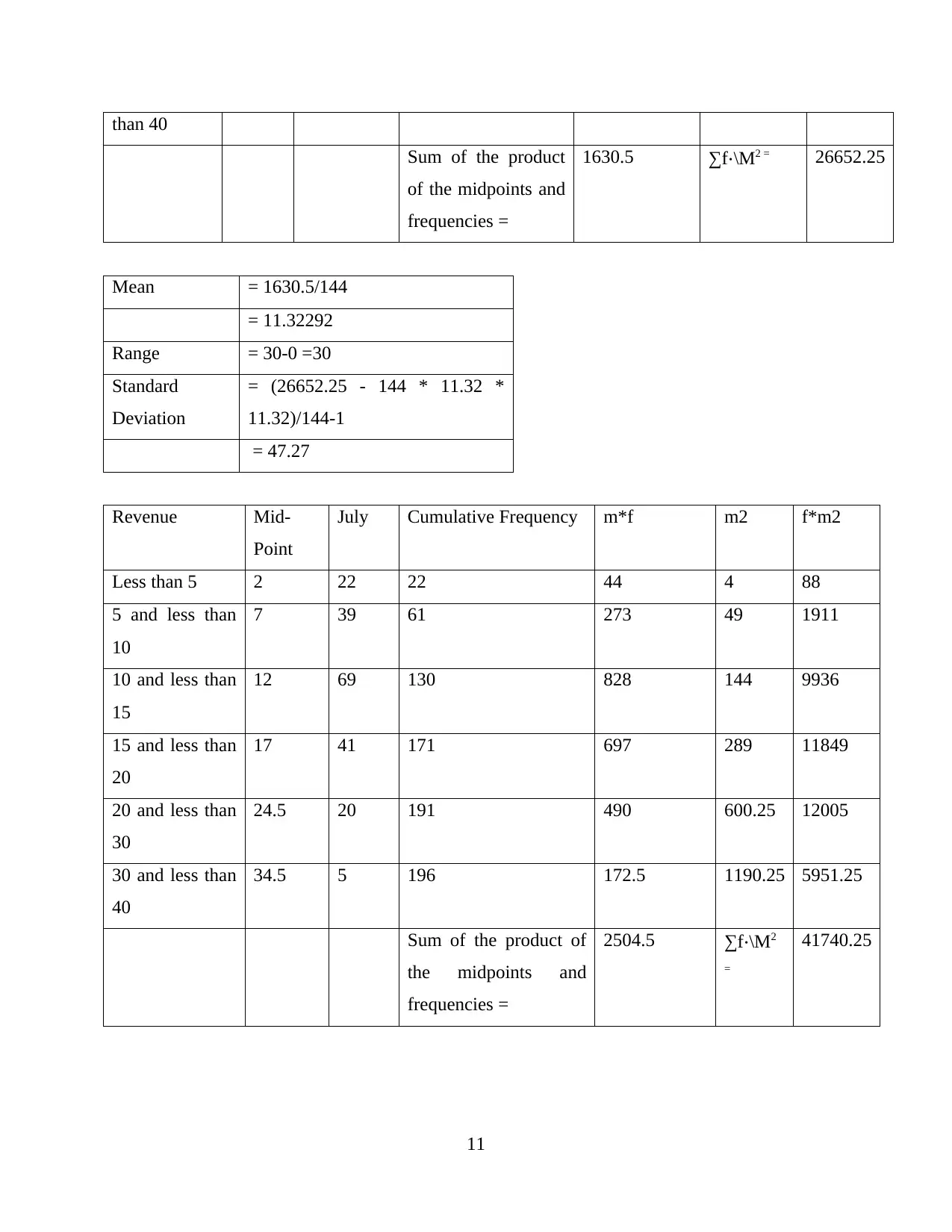
than 40
Sum of the product
of the midpoints and
frequencies =
1630.5 ∑f⋅\M2 = 26652.25
Mean = 1630.5/144
= 11.32292
Range = 30-0 =30
Standard
Deviation
= (26652.25 - 144 * 11.32 *
11.32)/144-1
= 47.27
Revenue Mid-
Point
July Cumulative Frequency m*f m2 f*m2
Less than 5 2 22 22 44 4 88
5 and less than
10
7 39 61 273 49 1911
10 and less than
15
12 69 130 828 144 9936
15 and less than
20
17 41 171 697 289 11849
20 and less than
30
24.5 20 191 490 600.25 12005
30 and less than
40
34.5 5 196 172.5 1190.25 5951.25
Sum of the product of
the midpoints and
frequencies =
2504.5 ∑f⋅\M2
=
41740.25
11
Sum of the product
of the midpoints and
frequencies =
1630.5 ∑f⋅\M2 = 26652.25
Mean = 1630.5/144
= 11.32292
Range = 30-0 =30
Standard
Deviation
= (26652.25 - 144 * 11.32 *
11.32)/144-1
= 47.27
Revenue Mid-
Point
July Cumulative Frequency m*f m2 f*m2
Less than 5 2 22 22 44 4 88
5 and less than
10
7 39 61 273 49 1911
10 and less than
15
12 69 130 828 144 9936
15 and less than
20
17 41 171 697 289 11849
20 and less than
30
24.5 20 191 490 600.25 12005
30 and less than
40
34.5 5 196 172.5 1190.25 5951.25
Sum of the product of
the midpoints and
frequencies =
2504.5 ∑f⋅\M2
=
41740.25
11
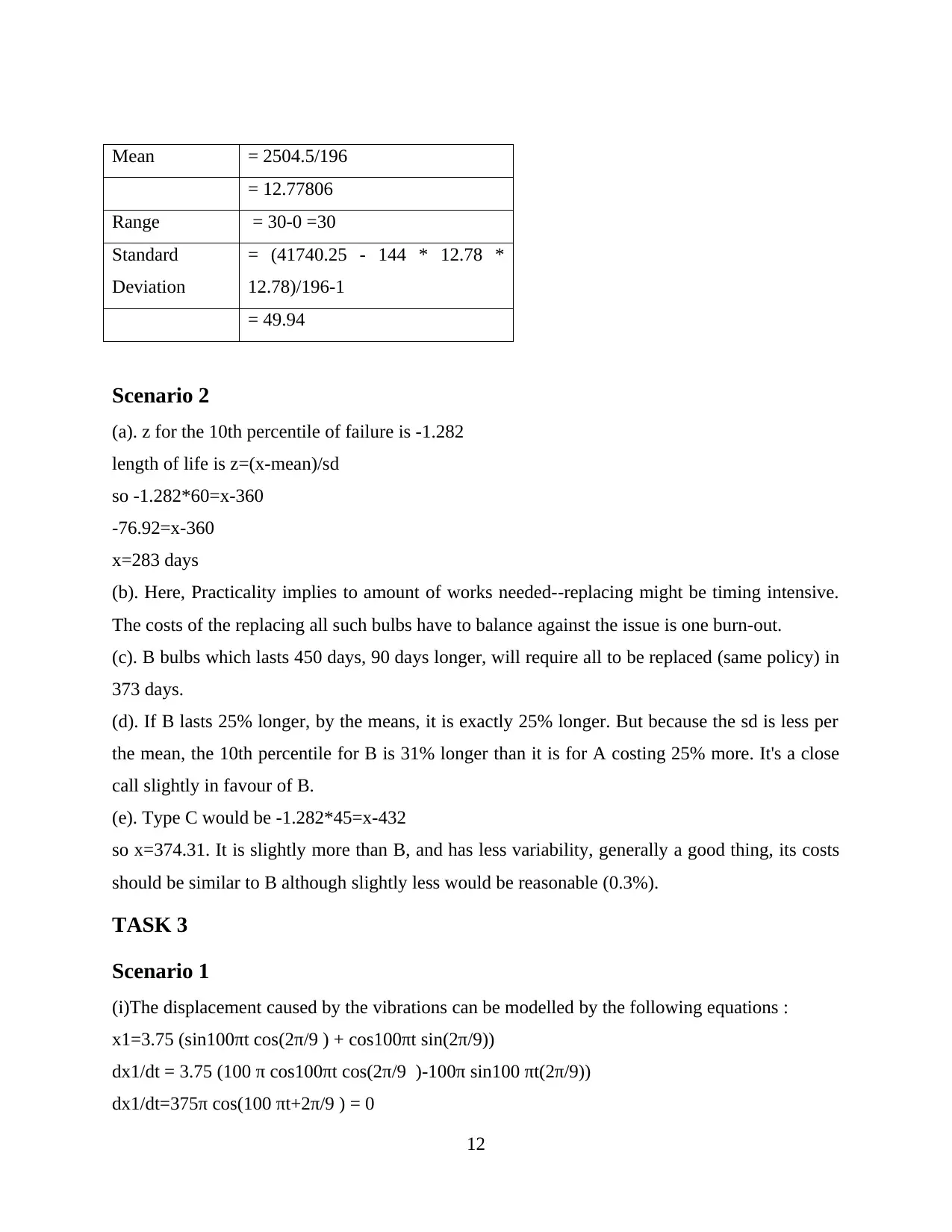
Mean = 2504.5/196
= 12.77806
Range = 30-0 =30
Standard
Deviation
= (41740.25 - 144 * 12.78 *
12.78)/196-1
= 49.94
Scenario 2
(a). z for the 10th percentile of failure is -1.282
length of life is z=(x-mean)/sd
so -1.282*60=x-360
-76.92=x-360
x=283 days
(b). Here, Practicality implies to amount of works needed--replacing might be timing intensive.
The costs of the replacing all such bulbs have to balance against the issue is one burn-out.
(c). B bulbs which lasts 450 days, 90 days longer, will require all to be replaced (same policy) in
373 days.
(d). If B lasts 25% longer, by the means, it is exactly 25% longer. But because the sd is less per
the mean, the 10th percentile for B is 31% longer than it is for A costing 25% more. It's a close
call slightly in favour of B.
(e). Type C would be -1.282*45=x-432
so x=374.31. It is slightly more than B, and has less variability, generally a good thing, its costs
should be similar to B although slightly less would be reasonable (0.3%).
TASK 3
Scenario 1
(i)The displacement caused by the vibrations can be modelled by the following equations :
x1=3.75 (sin100πt cos(2π/9 ) + cos100πt sin(2π/9))
dx1/dt = 3.75 (100 π cos100πt cos(2π/9 )-100π sin100 πt(2π/9))
dx1/dt=375π cos(100 πt+2π/9 ) = 0
12
= 12.77806
Range = 30-0 =30
Standard
Deviation
= (41740.25 - 144 * 12.78 *
12.78)/196-1
= 49.94
Scenario 2
(a). z for the 10th percentile of failure is -1.282
length of life is z=(x-mean)/sd
so -1.282*60=x-360
-76.92=x-360
x=283 days
(b). Here, Practicality implies to amount of works needed--replacing might be timing intensive.
The costs of the replacing all such bulbs have to balance against the issue is one burn-out.
(c). B bulbs which lasts 450 days, 90 days longer, will require all to be replaced (same policy) in
373 days.
(d). If B lasts 25% longer, by the means, it is exactly 25% longer. But because the sd is less per
the mean, the 10th percentile for B is 31% longer than it is for A costing 25% more. It's a close
call slightly in favour of B.
(e). Type C would be -1.282*45=x-432
so x=374.31. It is slightly more than B, and has less variability, generally a good thing, its costs
should be similar to B although slightly less would be reasonable (0.3%).
TASK 3
Scenario 1
(i)The displacement caused by the vibrations can be modelled by the following equations :
x1=3.75 (sin100πt cos(2π/9 ) + cos100πt sin(2π/9))
dx1/dt = 3.75 (100 π cos100πt cos(2π/9 )-100π sin100 πt(2π/9))
dx1/dt=375π cos(100 πt+2π/9 ) = 0
12
⊘ This is a preview!⊘
Do you want full access?
Subscribe today to unlock all pages.

Trusted by 1+ million students worldwide
1 out of 19
Your All-in-One AI-Powered Toolkit for Academic Success.
+13062052269
info@desklib.com
Available 24*7 on WhatsApp / Email
![[object Object]](/_next/static/media/star-bottom.7253800d.svg)
Unlock your academic potential
Copyright © 2020–2025 A2Z Services. All Rights Reserved. Developed and managed by ZUCOL.
